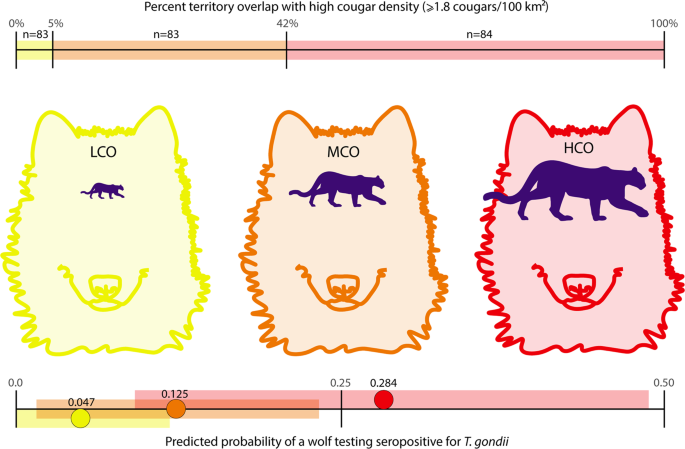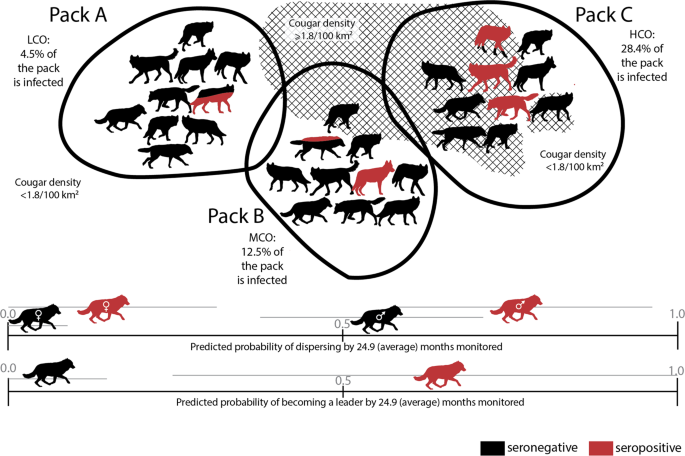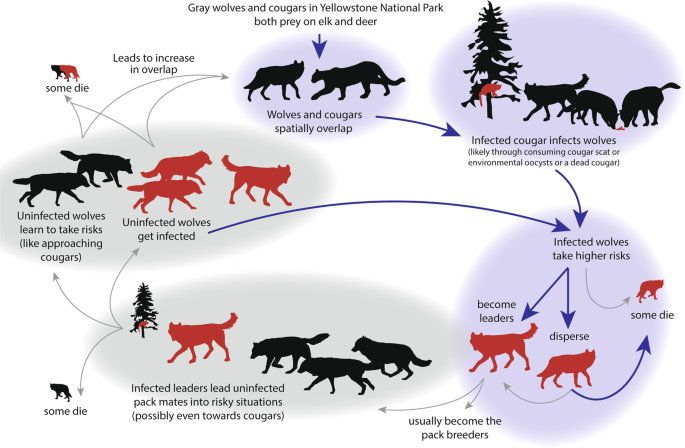狼网 | 有了它帮忙,更快当“狼王”

图片来源:JOHN MORRISON/GETTY
弓形虫有时被称为“精神控制”寄生虫——它可以感染动物的大脑、扰乱动物的行为,从而杀死宿主。如今,美国研究人员发现,被弓形虫感染的狼可能从这些改变思维的“把戏”中受益。
这项11月24日发表于《通讯-生物学》的研究发现,被弓形虫感染使狼变得更勇敢,更有可能成为狼群首领或寻找其他栖息地,这带来了更多繁殖机会。
“我们真的低估了这些寄生虫带来的后果。”未参加该研究的美国诺瓦东南大学的Eben Gering说,“这些发现可能显露了弓形虫对野生生态系统动态意义的冰山一角。”
弓形虫是一种单细胞寄生虫,只在家猫和其他猫科动物中繁殖。人们早就知道,感染弓形虫的啮齿动物会失去对捕食者的恐惧。因为大脑以某种方式增加了多巴胺和睾酮,进而增强了宿主的勇气和冒险精神。
埃默里大学生物学家Jaap de Roode说:“这些寄生虫正在使用一些‘心理控制’或‘性格控制’帮助自己完成生命周期。这会产生难以预料的后果。”
其后果不限于啮齿动物。2016年,加蓬研究人员发现,被弓形虫感染的圈养黑猩猩不再厌恶豹的尿。去年,另一个研究小组描述了肯尼亚受弓形虫感染的鬣狗幼崽如何冒险接近狮子。
这次,当得知黄石国家公园一些狼感染了弓形虫后,蒙大拿大学博士生Connor Meyer与黄石国家公园生物学家Kira Cassidy合作,研究了这种寄生虫是否也会改变狼的行为。
研究人员对公园的灰狼进行了长达26年的研究,包括从采集的血液样本中获得的弓形虫检测结果。他们还检查了美洲狮的数据,因为弓形虫可以在美洲狮中繁殖。
结果发现,在有很多美洲狮活动的地区,狼更容易感染弓形虫。作者指出,这些狼很可能是从美洲狮身上感染弓形虫的。
结合感染数据和现场观察,研究人员还发现,被弓形虫感染的狼更有可能成为狼群首领,也更有可能在年轻时离开狼群,去寻找新的领地或其他狼群,就像被感染的啮齿动物变得更渴望探索一样。
Cassidy说:“在一些情况下,狼甚至它们的族群可能会变得非常成功,因为它们更愿意冒险,会不断突破界限。”
与啮齿类动物一样,狼的冒险也会带来风险。四处游荡的狼可能更容易被汽车撞到,或者离开保护地最终被猎人射杀。被感染的狼群首领也有可能在交配时传播寄生虫,从而不利于怀孕。
总的来说,Cassidy怀疑,从长远来看,感染的风险可能大于益处。“狼一出生就活在生死边缘。”(来源:中国科学报 王方)
a Map of cougar density and T. gondii seroprevalence in wolves in Yellowstone National Park (YNP). Yellow indicates cougar density <1.8/100 km2 and purple indicates cougar density ≥1.8/100 km2. Pie charts show the T. gondii seroprevalence (seropositive=black; seronegative=white/transparent) from wolves living in nine general areas throughout YNP, pooled across years 2000–2020. b A sample year (2015) of wolf pack territory minimum convex polygons in YNP along with each pack’s cougar overlap index level (LCO, MCO, or HCO) based on percentage of overlap with cougar density ≥1.8/100 km2 (purple).
Gray wolves with T. gondii serology results were divided into one of three categories relative to their average annual overlap with cougar density ≥1.8/100 km2 (top bar): Low Cougar Overlap (LCO in yellow) indicates wolves living in areas with 0.0 to 5.0% overlap, Moderate Cougar Overlap (MCO in orange) indicates 5.1–42.0% overlap, and High Cougar Overlap (HCO in red) indicates 42.1–100% overlap. This results in three categories of nearly equal sample size. The lower bars show the predicted probabilities, with 95% confidence intervals, of a seropositive T. gondii test for gray wolves living in LCO (yellow), MCO (orange), or HCO (red). Predicted probabilities are based on the full model.
Predicted probabilities of dispersing for male (blue) and female (orange) gray wolves with a seropositive (solid lines) or seronegative (dashed lines) T. gondii test. The shaded areas indicate 95% confidence intervals. The gray line indicates the average number of months (24.9) a wolf is monitored in YNP.
Schematic of results from both the demographic and the behaviour analysis. Displayed at the top are three sample packs with different cougar overlap categories and their corresponding predicted probabilities of T. gondii infection (seronegative in black; seropositive in red) based on the best-fit demographic model. Red-filled wolves indicate the expected percent of infected wolves out of 100% (e.g., total number of wolves in the pack). Cougar density ≥1.8/100 km2 is depicted with hatch-marks. Cougar density below 1.8/100 km2 is all the area outside of the hatch-marks. At the bottom are the predicted probabilities with 95% confidence intervals (gray lines) based on the best-fit behaviour models, of two risky behaviours: dispersing and becoming a pack leader for seronegative and seropositive wolves at 24.9 months monitored (the average number of months wolves in this study were monitored).
Schematic of the possible feedback loop involving gray wolves, cougars, and T. gondii. Red figures indicate seropositive animals and black indicates seronegative animals. Thick, purple arrows indicate links supported by this or other published literature. Thin, gray lines indicate hypothesized relationships.

|

|

|

|

|
北京网笑信息技术有限公司 仅提供技术支持 违法和不良信息举报中心






